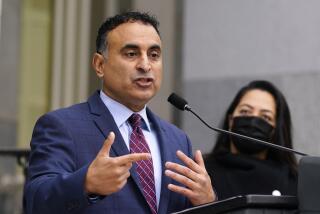Why California’s proposed law on deadly police force isn’t as tough as it seems
- Share via
Reporting from SACRAMENTO — In the aftermath of several controversial police shootings in California, activists and victims’ families have hoped their anguish would lead to action.
They have protested, pleaded and lobbied for a law that would clear long-standing hurdles to criminal prosecution in some cases.
But the focus of their hopes — a bill facing its first public hearing next week — may come up short. Experts on both sides of the debate say the proposal won’t be what community groups want or what law enforcement fears.
“I don’t think it’s going to end proactive policing, and I don’t think it’s going to cause more officers to be locked up,” said John Burris, a civil rights attorney who specializes in police shootings. “I think it’s more of a scare tactic than not.”
In fervent rhetoric at the Capitol, police reform activists have said Assembly Bill 392 will make it easier to criminally charge officers who use guns too recklessly, especially against people of color. And, many believe, it could provide what they see as elusive justice for cases like that of Stephon Clark, who was shot by Sacramento officers after they mistook his cellphone for a weapon — sparking the legislation.
Law enforcement advocates argue that, if enacted, the bill could prompt police to hesitate, putting “blue lives” and the public in danger in critical moments, and would criminalize officers as they react to risky and fast-moving situations.
But there is quiet consensus from some police, lawyers and academics — even those who support or oppose the measure on other grounds — that it will do little if any of that.
“There are many reasons why police kill so many people … and there are many reasons why they are not held accountable, and this bill only really addresses [some] of those,” said Lizzie Buchen, legislative advocate of the American Civil Liberties Union of Northern California, one of the main backers of the measure. “This is just one step, and we will need to see a lot of other changes to make a real impact.”
Her tempered expectations are echoed by some opponents.
“I feel bad for that segment of the public that really thinks this is going to be the savior of ‘murder by police.’ It’s not,” said Ed Obayashi, a Plumas County sheriff’s deputy and legal advisor who opposes the bill. “You are going to have a significant constituency out there that … demands justice based on 392, and it’s not going to happen.”
The undercurrent of acknowledgment about the bill’s limitations exposes uncomfortable truths as California tries to push law enforcement into a new way of doing business: Preventing police shootings is difficult to legislate, and a circumscribed standard for when lethal force can be used is neither an easy legal fix nor practical without broader shifts in policing to back it.
“Unless you change the hiring, training and accountability, we’re not going to change the outcomes by legislation,” said Rick Braziel, a former police chief and current member of the state’s Commission on Peace Officer Standards and Training.
Forcing broader reforms is at the heart of AB 392, though it is seldom framed in those terms. The bill tackles, in a roundabout way, a national controversy over whether police should be guardians or warriors — trained more for peaceful intervention or always expecting worst-case scenarios. The distinction is divisive even among law enforcement, and discussion of it angers some who say police are always guardians and trained to respect the sanctity of life. But departments now are largely free to cultivate their own cultures — and their own rules of conduct.
AB 392 would put those choices under a microscope when fatalities occur.
In reality, the legislation does little more than codify into California criminal code standards that already exist in civil law and in the policies of some progressive departments.
Under a ruling delivered by the U.S. Supreme Court in 1989, police are justified in using deadly force if another officer in the same situation would reasonably do the same. The standard is narrow, judging only the moments immediately before the use of deadly force to determine whether officers felt they or another person were in imminent danger.
States have the right to build upon the protections given to citizens under federal law. The California Supreme Court opened the door for a broadened standard for use of force in a 2013 ruling about a police shooting in San Diego that involved a suicidal man, Shane Hayes.
The Hayes ruling allowed civil negligence claims against law enforcement to include more than the moments just before the use of lethal force, stretching to cover officers’ tactics and decisions in the lead-up to the fatal encounter.
Hayes had been staying with an ex-girlfriend, Geri Neill, in 2006 when he tried to kill himself. Neill said in a recent interview that Hayes had previously been placed in a psychiatric hold by police and that on the night he died, he threatened to kill himself by breathing car exhaust, drowning himself in a pool or hanging himself.
Neill tried to tell police about Hayes’ mental history, but they wouldn’t listen, she said. They also failed to check his history with police. Two officers entered the house and shot Hayes after encountering him in the kitchen holding a knife. Hayes’ family filed a federal civil suit, resulting in the ruling.
AB 392 would take the idea of negligence leading to the use of deadly force and put it in the state’s penal code, though largely without any enhanced ability to charge officers — unless their conduct is so out of normal standards that existing laws would enable prosecution anyway, Obayashi said.
Braziel said many departments already incorporate the Hayes decision into their policies and training to avoid lawsuits and improve outcomes. Some agencies that have focused on de-escalation and less-lethal force have seen a decline in shootings.
“Smart agencies are already applying the tactic standard in their discipline and review of encounters,” Braziel said.
By bringing pre-shooting conduct into criminal code, AB 392 would obligate district attorneys to incorporate tactics into their investigations of police shootings, and thereby compel recalcitrant departments to embrace the idea or face scrutiny if not hard consequences — effectively putting them on the hook to explain why force wasn’t only reasonable in the moment, but necessary in the big picture. It would also give more weight to public criticism of those tactics by making them part of the official discussion.
But because AB 392 introduces the notion of criminal negligence with no definition, it will probably leave a determination of what that means to the courts. Law enforcement is especially critical of this aspect of the bill, arguing that it allows laypeople to second-guess police.
“It’s going to take years and cost millions to define what is negligent tactics, and more specifically what are criminally negligent tactics,” said Bruce Praet, a lawyer who represents law enforcement agencies. “In the meantime, who becomes the guinea pig? Which officers get sacrificed to test the new law? Which D.A. is going to be motivated by the pressures of protesters outside his offices?”
Buchen said that criminal negligence is defined by case law and that the bill would allow prosecution only in a “limited number of circumstances.” She said getting district attorneys to prosecute remains a “huge barrier” even if the bill passes.
Eugene O’Donnell, a former NYPD cop and expert on policing with the John Jay College of Criminal Justice in New York, said the reluctance to prosecute goes beyond district attorneys.
“I don’t think convicting on-duty police officers for shootings is going to happen no matter how the law is changed. I don’t think there is an appetite to do it,” O’Donnell said. “Grand juries don’t want to indict, juries don’t want to convict, judges don’t want to sentence.”
Praet pointed out that in the Hayes decision, “the [California] Supreme Court didn’t say there were particular tactics officers have to use … it just said the tactics have to be reasonable.”
His interpretation matters because he is a founder of Lexipol, a for-profit company that sells policy manuals to law enforcement departments. Lexipol polices are used by 93% of California police and sheriff’s departments, according to a study by UCLA, which called the company “a force to be reckoned with in American policing.”
Despite AB 392 not being as robust as some believe, supporters including the Rev. Al Sharpton, who spoke on the Capitol steps in favor of the measure, said it is still worthwhile because it “raises the bar.” And though it probably won’t lead to many criminal prosecutions of police, the opposition of law enforcement is driven partly by an aversion to forced change, steered by those who don’t wear a uniform. “The system isn’t broken,” Praet said.
For Chelsey Hayes, Shane Hayes’ daughter, there is no doubt that California officers should be held responsible for more than the moment of deadly force. She said she is grateful the Hayes standard could become law, because she has never felt closure for her loss and is angry with how her dad was portrayed.
She was 12 when her father was shot and remembers him as her “best friend,” a funny guy who hung out at the beach with her the summer before his death and took her to Sea World.
“People do need to look at how [police] handle situations, and I think they do need to be questioned with how they went about it,” said Hayes, now 25. “I want people to know how good my dad was and how wrong it was of those officers to take his life…. My dad, yeah, he struggled with depression and he didn’t handle it the best, but he just needed help, and I wish that our law enforcement, we could trust them to come and help.”
More to Read
Get the L.A. Times Politics newsletter
Deeply reported insights into legislation, politics and policy from Sacramento, Washington and beyond. In your inbox twice per week.
You may occasionally receive promotional content from the Los Angeles Times.











